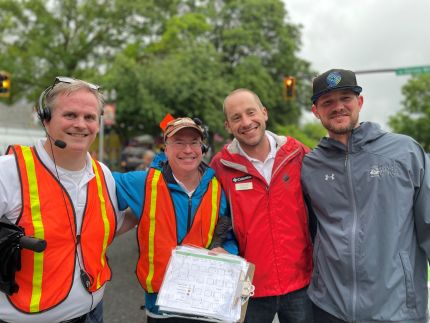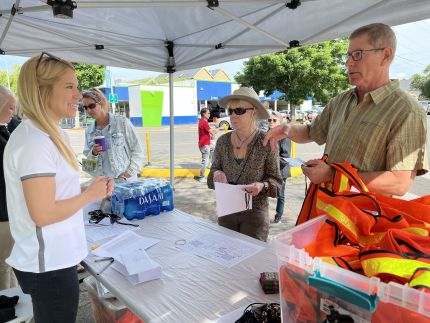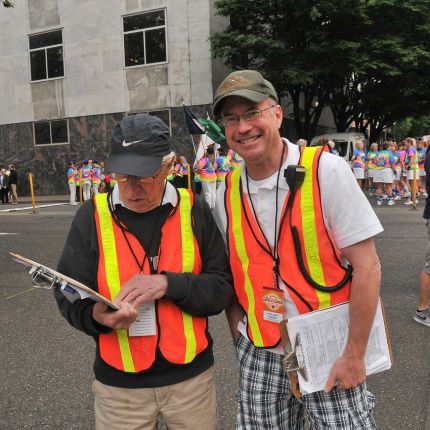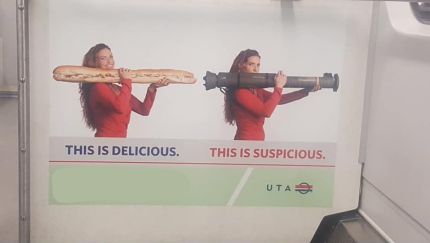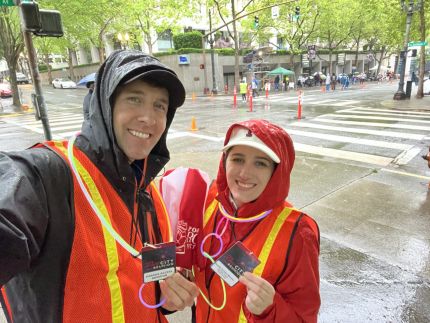Parade Guides at Barricades: Difference between revisions
| Line 69: | Line 69: | ||
* To receive a hard copy of the Operations Plan, including your own map and assignment as needed; | * To receive a hard copy of the Operations Plan, including your own map and assignment as needed; | ||
* A reflective vest if you are not a NET volunteer and don't already have one; | * A reflective vest if you are not a NET volunteer and don't already have one; | ||
* | * Bottled water if needed; | ||
* Your questions answered. | * Your questions answered. | ||
Revision as of 15:40, 22 May 2023
Beginning with the 2023 Rose Festival, Portland NET and the Portland Rose Festival are working together to keep Portland's most prominent celebration safe by recruiting volunteers as Parade Guides. Parade Guides monitor vehicular traffic at barricades and serve as a general information source for paradegoers. This is a planned event deployment NET/PBEM reserves for the Rose Festival; NET does not generally deploy for Parade Guide responsibilities for any other event.
This article serves as a general job aid and volunteer position description for volunteers (both NET and non-NET) serving as Parade Guides.
...
...
Background
Volunteer Guides deploy to each of the Rose Festival's parades: the Starlight Parade, the Junior Parade, and the Grand Floral Parade. Each Parade Guide will receive via email an Operations Plan that includes relevant contact information, check-in locations, radio frequencies, and other details specific to each event. Event-specific information is NOT included in this article; if a Parade Guide has not received their Operations Plan three days before the event, they should email net@portlandoregon.gov to request it.
...
Mission
Volunteer Guides help keep Portland Rose Festival events safe and fun by actively managing street closure barricades. Volunteers will help act as "eyes and ears" around the parade route and work with our on-site safety team to report any incidents. Responsibilities include:
|
We encourage NET volunteers to treat this as a tactical radio comms exercise as well, and to bring an FRS/GMRS radio. Radio frequencies will be included in the event operations plan.
...
Volunteer Coordination Center
Each parade will include at least one Volunteer Coordination Center to coordinate volunteers and their radio communications. The location of a Coordination Center will be included in the Operations Plan. Parade Guides should plan an in-person check in at the Coordination Center where they will receive their assignment, any parade materials they may need, and to check they have everything they need (including answers to questions).
Roles at a Coordination Center will include:
- Parade Guide Lead: This person (a PBEM staffer) effectively serves as the Incident Commander for Parade Guides. They will have an 800 MHz radio to communicate with the Portland Emergency Coordination Center (ECC).
- Check-in/Check-out: Specializes in checking in the Parade Guides when they arrive at the post and giving them their barricade assignment. When a Parade Guide checks out, the person(s) in this role can accept the check-out either in person or by radio.
- Tactical Radio Lead: Monitors the FRS frequency Parade Guides are speaking on and moves the frequency if necessary.
- Runners: Volunteer who can run critical messages to a barricade if the Parade Guide at a location is not available by cell phone or radio. Runners will also take over for Parade Guides who need to leave post to use the restroom.
...
What To Expect: The Operations Plan
All Parade Guide volunteers should expect to receive an electronic copy of the Operations Plan no more than three days before your shift, and a hard copy will be provided to you when you check in on parade day. Please do not request a copy of the Operations Plan if the parade is more than three days off.
The Operations Plan is a single page document that has the following mission critical information:
- Parade day timeline, including check-in and check-out times;
- Location of restrooms for volunteers;
- Location of the Volunteer Coordination Center;
- Relevant parade day phone numbers (e.g. cell phone numbers of personnel in the Coordination Center);
- Tactical radio frequencies;
- Lists of required and recommended equipment;
- Review of radio protocols;
- Review of emergency procedures.
...
What To Expect: Parade Day
Before leaving home
Before leaving home for your volunteer shift:
- Have your route from home planned. If you're driving, where will you park your vehicle while volunteering? (Recommended parking options for you will be provided via email before your shift) How much time will you need to get from your home to check in at the Coordination Center?
- If you're taking the bus, plan your trip with TriMet at https://trimet.org/home/planner.
- Check your equipment and make sure you have everything you want. We recommend having it prepped and ready to go the night before.
- If you have a smartphone, have this article loaded up on your browser so you can reference it as needed.
- Use the bathroom before you leave home. Portable restrooms will be available to volunteers near most posts, but fewer bathroom breaks minimizes the effort moving Parade Guides around to cover unstaffed barricades.
...
Checking In: Coordination Center
Every Parade Guide should check in at the appointed time and location (which will be the Volunteer Coordination Center) specified on the Operations Plan. When you check in, you can expect:
- To receive a hard copy of the Operations Plan, including your own map and assignment as needed;
- A reflective vest if you are not a NET volunteer and don't already have one;
- Bottled water if needed;
- Your questions answered.
...
Post procedures
As a general rule, Parade Guides are to remain at their posts unless otherwise directed by Coordination Center. If you need to leave your post (e.g. for a bathroom break), contact the Coordination Center to request a runner to take over for you while you are gone.
- Be aware of your surroundings: Always be aware of your surroundings and the parade route. Pay attention to where the parade is coming from and where it's going. Always stay alert and keep an eye out for potential hazards. If you notice something that could be dangerous, notify the Volunteer Coordination Center immediately.
- Know emergency procedures: Be familiar with the emergency procedures in case of an accident or an emergency situation. Know who to contact and what to do in such situations.
- Communicate with the public: If someone is trying to cross the barricade, communicate with them and explain the reason for the barricade. Be firm but polite, and ensure that people understand the importance of not driving through the barricade. Remember that you should not physically try to stop anyone from going through a barricade.
...
Hazard considerations
Parade Guides should stay alert for hazards that can put the safety of attendees and volunteers at risk. Those hazards might include:
- Driver behavior: Confused and misdirected drivers can become unruly and may try to cross a barricade. It's important to stay alert and communicate effectively to ensure that everyone remains safe.
- Inclement weather: Portland weather can be unpredictable, and sudden changes in weather conditions can pose a hazard to Parade Guides. Heat exhaustion, dehydration, hypothermia, and other weather-related hazards can be a concern.
- Medical emergencies: During the parade, there may be medical emergencies that require immediate attention. It's important to know the emergency procedures and know how to bring medical responders to someone experiencing a medical emergency.
- Intoxication: Some parade attendees may become intoxicated, leading to unruly behavior and potential safety hazards. It's important to monitor the crowd and report any suspicious or dangerous behavior.
- Poor communication: Poor communication can lead to confusion and accidents. It is essential to have clear communication channels with the Volunteer Coordination Center and know how to reach them by radio or by cell phone.
...
- Managing a Vehicle Stopped at Your Post -
If an unauthorized vehicle stops at your post, the driver is possibly confused and/or angry (not to mention cognitively overloaded); approach the situation with both caution and empathy and call for support if you feel you need it. NEVER try to keep a vehicle stopped by putting yourself in front of it.
- At all times, position yourself so you are not directly in front of the vehicle or side mirrors that could clip you if the vehicle suddenly took off.
- While addressing the driver, maintain your situational awareness.
- At all times possible, try not to simply tell the driver they're in the wrong place and need to turn around...that could spark a confrontation. Instead, talk with the driver about where they need to go and help them with directions to get there. Your Operations Plan will come with a QR code that the driver can scan and will bring up a map on a smartphone of the surrounding area.
- If a driver threatens you or you feel threatened, your job is done. End engagement, stand back and contact the Volunteer Coordination Center for support.
- As they leave your post, stand well away from the moving vehicle and stay aware of how/where it's moving until it has left your post.
...
- EMERGENCY PROCEDURES -
When an emergency happens, stay calm and remember that YOU are the eyes and ears for professionals until they arrive. Do not try to resolve an emergency by treating a patient or putting yourself in harm's way. We need you to gather information and transmit that data to the Volunteer Coordination Center so that responders can resolve the situation quickly and safely.
- Emergency Medical -
A medical emergency is any medical condition you would call 911 for. That may include persons who are unconscious, not breathing, having trouble breathing, bleeding, or experiencing chest pains.
If you observe a medical emergency:
- FIRST, very quickly ask others in the crowd to assist the person experiencing the emergency (if they're not already);
- SECOND, contact the incident to the Volunteer Coordination Center (use the Communications protocols).
- THIRD, be prepared to answer the following clarifying questions:
- Location: what is the nearest cross streets?
Your most important job is to provide information; do not render aid. This may feel counterintuitive, but it is the best way to help someone experiencing an emergency.
- Vehicle Through Barricade -
If a vehicle drives through your barricade:
- Yell a warning/blow a whistle in the same direction the vehicle is heading if people are in immediate danger;
- Remain at your post and contact the Volunteer Coordination Center;
- Keep eyes on the vehicle for as long as you can, paying attention to
- Vehicle appearance (color, make, model, license plate)
- Approximate speed
- Direction of travel
- Appearance/behavior of driver
- Good tips on vehicle identification HERE
- Do not attempt to stop the vehicle yourself and do not place yourself in danger to get identifying information.
- Active Threat -
A violent attack on the parade is highly unlikely; but sadly, not impossible.
- In the event of an active shooter, follow RUN > HIDE > FIGHT guidance (see video to the right);
- If an explosive device detonates, leave the area immediately and encourage others to do the same. A secondary device may be near the site of the first explosion intended to maximize casualties.
...
Communications protocols
For message clarity and speed, please use these talking protocols when communicating with the Coordination Post (whether by radio or by cell phone).
- Begin with naming who you are trying to reach, followed by identifying your barricade number; this is the "Hey you, it's me" approach to comms. For example, let's say Barricade 12 was calling the Coordination Post. The conversation would go like this:
- "Coordination Post this is Barricade 12"
- "Barricade 12, Coordination Post, go ahead" (or, Coordination Post may say "Standby", asking you to hold your message...in that case, wait until Coordination Post says "Barricade 12 go ahead")
- Proceed with your message.
- Next, depending on your message, use one of the following radio scripts:
- "A car ran my post at Barricade [NUMBER]": Used to to communicate a vehicle that crossed a barricade at speed, and/or appears to present a threat.
- "I have an emergency at Barricade [NUMBER] and I need [police/medical]": Used to communicate an emergency at a post that needs a response.
- "A vehicle has bypassed my post at Barricade [NUMBER]": Used to communicate that a driver has driven around the barriers, as in the case of a frustrated or disoriented driver, but does not appear to be overtly threatening.
- After using the radio script, stand by to receive a reply form the Coordination Post to acknowledge and receive clarifying questions.
...
Radio Use
If you are using an FRS/GMRS radio, please be sure to:
- Check the Operations Plan for which frequencies the Coordination Post will be using. There will be two: an emergency frequency, and a non-emergency frequency (to request coverage during a bathroom break, for example, and for routine check-ins). Have your radio set to the emergency frequency.
- Be prepared to change frequencies at the direction of the Coordination Post. FRS/GMRS frequencies are public and it's not impossible for our chosen frequency getting hijacked by 12-year-olds making fart jokes (this has actually happened). Listen for the Coordination Post requesting you to move frequencies. If all frequencies are crowded, the Coordination Post may ask for communications to be moved to cell phones.
- When talking, press the push-to-talk button, wait two seconds, and then speak.
...
Demobilization (Volunteer Check-Out)
Volunteers should expect check-out time to be listed on the Operations Plan. However, please do not check out until the Volunteer Coordination Center calls for check-out over radio or SMS. When check-out is called, do the following:
- If you do not have anything to return to the Volunteer Coordination Center, such as a reflective vest, you can check out by radio or SMS text (please do not check out by calling). Wait to receive acknowledgement.
- If you have materials to return to the Volunteer Coordination Center, please check out in person. Or, check out by radio/SMS and then return the materials to the Rose Festival Office during business hours inside week after your shift (we may need what you're returning for the next parade).
- Inside the week after your shift, expect a brief feedback survey. Please complete it! Your feedback helps us shape procedures for future events.
...
Parade Guide Equipment
Required equipment
The following items are REQUIRED so that Parade Guides can complete their volunteer shifts safely and effectively.
- Your personal cell phone: Your cell phone is your communications lifeline and you will use it to call 911 if needed. The Parade Guide Coordination Center should have your cell phone number so they can call you from the post.
- Weather-appropriate and proper attire: You should wear comfortable clothes and shoes that allow you to stand for long periods. Considerations:
- Barricade positions are unsheltered and directly in the weather! Please be sure to stay informed of the weather forecast for the day of your posting and dress appropriately. If you are staffing the barricade in hot weather, wear light-colored clothing and a hat to protect yourself from the sun. In cold and wet weather, layer up.
- NET volunteers should wear their reflective NET vest and NET ID. Hard hats and full response kits are not required.
- Besides NET logos or approved CERT logos, no shirts, sweat shirts, jackets, or caps with any law enforcement, fire, medical, or emergency preparedness organizations.
- Footwear should be closed-toe; preferably comfortable and watertight sneakers you can stand in for long periods of time. Trail runners or hiking boots are most recommended. If your footwear is new, we suggest having it fully broken in before parade day.
- Personal water supply: Please bring enough water to keep yourself hydrated
...
Recommended equipment
These items will make your volunteer shift easier and more comfortable:
- Folding camp chair: We ask that Volunteer Guides remain standing as their physical capabilities permit in the time leading up to the parade. But after the parade begins, we recommend sitting at post and having a folding camp chair available. This is the number one item parade volunteers say they'd wish they brought when they don't!
- FRS/GMRS radio: We'll plan to be on an FRS frequency for tactical communications, but the Coordination Center will use cell phone voice/SMS for volunteers who don't have a radio.
- Umbrella: Is it raining? You'll wish you had one. Is the sun out? You'll wish you had one. Best to hedge your bets and bring an umbrella.
- Snacks: We recommend high protein snacks. Watch out for sugary snacks that crash your energy later.
- Sunscreen: Recommend SPF-50 or higher.
- Rain poncho: Good idea to find a light, inexpensive rain poncho and fold it into your pack.
- A whistle if you have one. You can use it to signal your location if responders are looking for you, and to signal a warning to others.
- First aid kit.
...
What not to bring
- Do not bring weapons of any kind to your volunteer shift. Bandage shears or small pocketknives are acceptable.
- Do not bring alcohol, drugs, or other intoxicants (legal or not) to your shift.
- Please leave pets at home! Service animals, naturally, are welcome.
...
